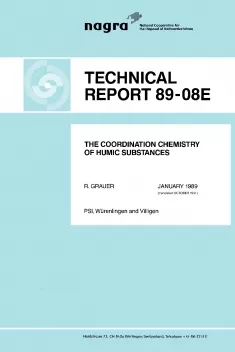
Technical Report NTB 89-08
The coordination chemistry of humic substances
Dissolved humic materials form ligands which can influence the speciation of certain radionuclides in natural waters and it is necessary to take account of this phenomenon in repository safety assessment model calculations.
In operational terms the dissolved humic materials can be subdivided into humic and fuIvic acids, both groups being poIyfunctional macromolecules with a large structural variety. The description of their solution chemistry is restricted to very simplifying models clue to the inhomogeneity of their properties.
The protolytic behaviour of humic materials is determined mainly by carboxyl- and phenolic OH-groups whose acidities are modified by substituents. A model which assumes a normal distribution of the pKa values for both acid groups would appear to have a good chemical foundation.
There are, however, no models available which give a basic description of the wide range of complexation properties of humic materials with dissolved metals and which are based on a chemically meaningful background. All of these models make very drastic simplifications and, although capable of reproducing experimental data, they do not allow any extrapolation to ranges of concentration outside those covered by the experiments.
By way of a minimal description, the humate complexes can be treated as a mixture of two to three single complexes with 1:1-stoichiometry. The stability constants and the concentrations of the individual ligands are then adjustable parameters which are dependent on the concentration conditions and are valid only for specific pH-values and ionic strengths. As there is no simple model describing the pH-dependence of complexation, most of the literature data (usually determined for low pH-values) are not in fact applicable in the case of natural waters.
Humic materials affect not only the solution chemistry of the metals but also their sorption onto minerals. The mineral surfaces are modified through adsorption of organic material which in turn aIters their sorption properties. These processes are understood in qualitative terms.
It is unlikely that a comprehensive predictive model of compIexation by humic materials will be available in the foreseeable future. It is therefore suggested that experiments which provide an empirical description of the metal/humic material interactions using realistic pH-values and metal/ligand ratios be carried out. Besides parameter studies and experiments in synthetic or formation waters, analogue studies could also serve as a useful tool.
